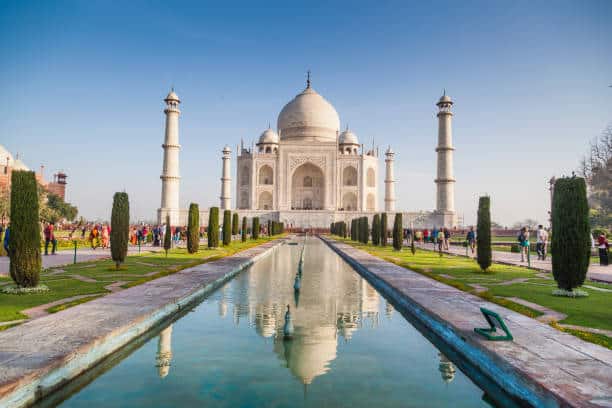Imagine a place so breathtaking that it leaves millions of visitors spellbound every year. That’s the Taj Mahal for you—a symbol of love, a masterpiece of architecture, and a UNESCO World Heritage Site. Located in Agra, India, this iconic monument is not just a tourist attraction; it’s an experience. Let’s explore why your next trip should include a visit to the Taj Mahal.
History of the Taj Mahal
The Legacy of Shah Jahan and Mumtaz Mahal
The story of the Taj Mahal is one of love and loss. Built by Emperor Shah Jahan in memory of his beloved wife Mumtaz Mahal, this mausoleum is a tribute to eternal love. After Mumtaz’s death in 1631, Shah Jahan commissioned the construction, which took over 20 years to complete.
Construction and Architecture
Completed in 1653, the Taj Mahal employed over 20,000 artisans. Its design incorporates Persian, Islamic, and Indian architectural styles, making it a unique blend of cultures.
The Architectural Marvel
The White Marble Splendor
The Taj Mahal’s pristine white marble changes hues throughout the day—pinkish at dawn, milky white during the day, and golden under moonlight. This visual transformation is part of its unparalleled charm.
Gardens and Layout
The Taj Mahal complex features a symmetrical garden known as the Charbagh. Divided into four parts by water channels, the garden enhances the monument’s ethereal beauty.
Intricate Inlay Work
Look closely, and you’ll see exquisite inlay work featuring semi-precious stones like jade, lapis lazuli, and turquoise, which decorate the walls with floral patterns.
Why Visit the Taj Mahal
A Symbol of Eternal Love
The Taj Mahal isn’t just a building; it’s a love story in stone. Its history and emotions resonate deeply, making it a place of profound significance.
UNESCO World Heritage Status
Recognized globally as a cultural treasure, the Taj Mahal is one of the Seven Wonders of the Modern World.
A Photographer’s Paradise
Every angle of the Taj Mahal offers a picture-perfect moment. Whether it’s a reflection in the water or the marble glowing under moonlight, photographers adore this place.
Best Time to Visit the Taj Mahal
The ideal time to visit the Taj Mahal is from October to March, when the weather is pleasant. Sunrise and sunset are particularly magical, and the full moon nights offer a once-in-a-lifetime view.
How to Reach the Taj Mahal
From Delhi to Agra
Agra is just a few hours away from Delhi. You can opt for the Yamuna Expressway or take a train from New Delhi Railway Station.
Transportation Options
Choose from taxis, buses, or luxury trains like the Gatimaan Express for a comfortable journey.
Ticketing and Entry Details
Tickets range from INR 50 for Indian citizens to higher prices for international tourists. Night viewing requires special tickets, which must be booked in advance.
Nearby Attractions
Agra Fort
Just a short drive from the Taj Mahal, Agra Fort is a UNESCO site that offers a glimpse into Mughal history.
Fatehpur Sikri
This ancient city is a marvel of Mughal architecture and worth a day trip.
Mehtab Bagh
This garden offers a stunning view of the Taj Mahal from across the Yamuna River.
Cultural Etiquette and Tips for Visitors
Respect the sanctity of the site by dressing modestly and adhering to photography rules. Avoid littering to help preserve the monument’s beauty.
Interesting Facts About the Taj Mahal
- The Taj Mahal is perfectly symmetrical.
- The minarets are slightly tilted outward to prevent them from falling on the main structure during an earthquake.
- Shah Jahan planned to build a black Taj Mahal across the river but was deposed before he could realize his vision.
Preserving the Taj Mahal
Over the years, the Taj Mahal has faced challenges like air pollution and overcrowding. Conservation efforts, including limiting visitors and banning vehicles nearby, are ongoing to protect this iconic structure.
Conclusion
The Taj Mahal is more than just a monument; it’s a testament to love, artistry, and cultural heritage. Visiting it is an experience that will stay with you forever. So, plan your trip, and let the Taj Mahal leave you awestruck.
FAQs
- What is the best time to visit the Taj Mahal?
The best time is during winter (October to March), especially at sunrise or sunset. - How long does a tour of the Taj Mahal take?
A visit typically takes 2-3 hours, but you might want to spend more time exploring the details. - Are there special tickets for night visits?
Yes, tickets for moonlit visits must be booked 24 hours in advance. - Is the Taj Mahal closed on any specific days?
Yes, the Taj Mahal is closed on Fridays for general visitors. - Can I bring food inside the Taj Mahal?
No, food and drinks are not allowed inside to maintain cleanliness and respect.



Comment (0)